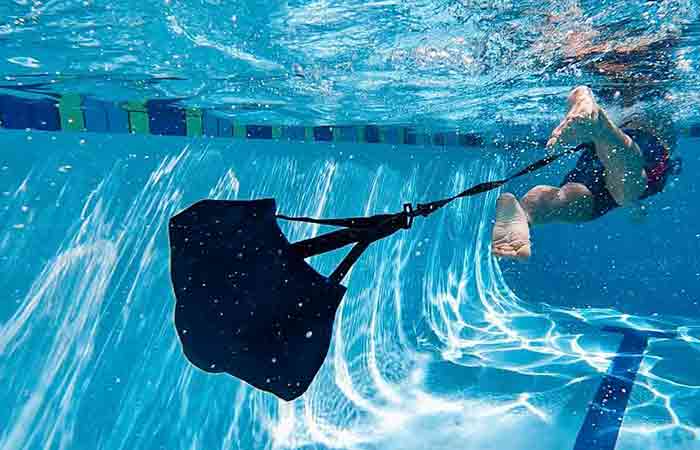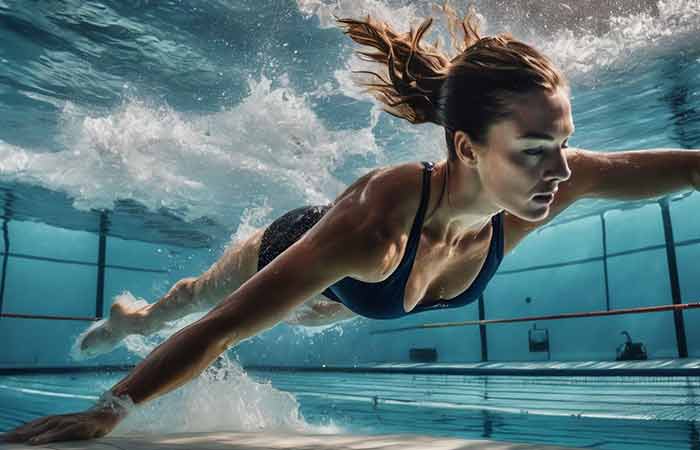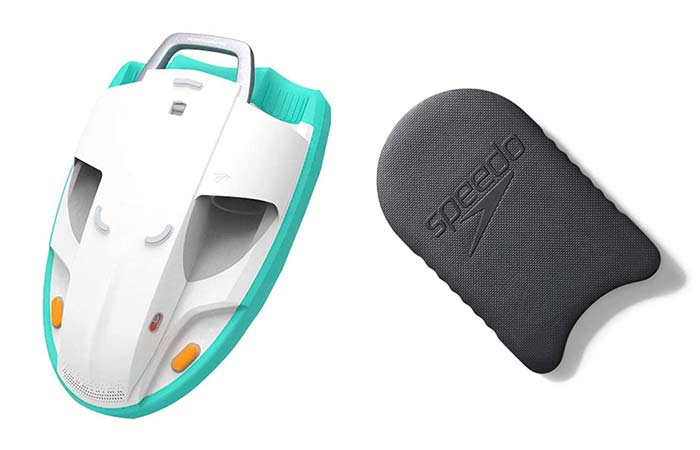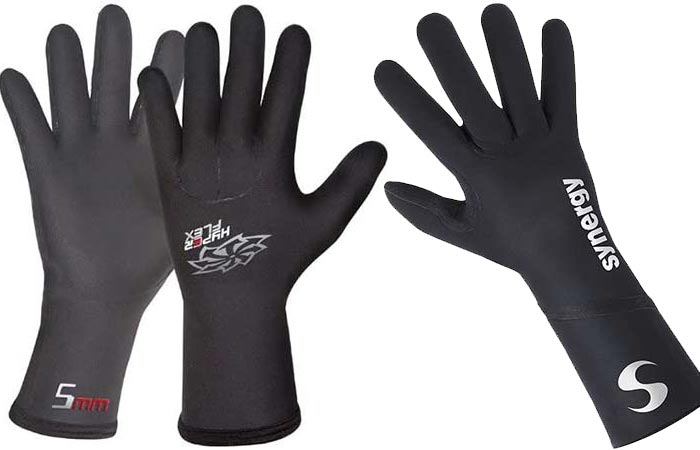Swim Parachutes-A Comprehensive Guide
As the world of swimming continues to evolve and athletes strive for new levels of excellence, innovative training tools are constantly being developed to help them achieve their goals. One such tool that has gained popularity among swimmers of all levels is the swim parachute.
Swim parachutes are an excellent training tool that adds drag and resistance to your time in the water. This resistance boosts muscular strength, endurance and technique when used properly.
Read on to learn more about swim parachutes including how they work, types/styles, benefits, how to choose the best, usage tips, plans, and more.
What is a Swim Parachute and How Does it Work?
Swim parachutes are basically training tools designed to provide resistance in the water, challenging swimmers and pushing their limits. They consist of a lycra, nylon, or polyester chute and cords, harnesses, clasps, or velcro that attach to your body and link to the chute.

How do they work, you ask?
When you wear the parachute and start swimming, the parachute’s central opening fills with water, creating drag as you move forward through the water. This drag slows you down a bit and makes it harder to move forward. But that’s a good thing!
The resistance created by the swim parachute challenges your muscles to work harder. Every stroke you take requires more effort and generates increased power. This helps to strengthen your muscles, especially in your arms, shoulders, and core.

But that’s not all. The swim parachute also helps you improve your technique. With the added resistance, you must maintain a streamlined body position and do your strokes well. This way, you’ll learn to swim with better form and efficiency, making you faster and more efficient in the water.
Types/Styles of swim parachutes
There are different types of swim parachutes that swimmers can use to enhance their training. Here are two common types:
- The belt attachment parachute
- Full-body parachute
Belt attachment parachute
Belt attachment parachutes are the most common type of swimming parachute. They are attached to your waist with a belt, and they have a large, open parachute that creates resistance as you swim.
Belt attachment parachutes are a great way to improve your swimming technique and build strength and power.
Full-body parachute
This type of parachute is a bit different because it covers your entire body. It is attached to a harness that you wear, allowing the parachute to create resistance as you move through the water.
The full-body parachute provides resistance not only to your upper body but also to your legs. This comprehensive resistance helps you engage more muscle groups, providing a full-body workout and enhancing your overall swimming performance.
However, full-body parachutes can be more challenging to use than belt attachment parachutes.
Benefits of Swim Parachutes
Using a swim parachute has been a game-changer for my swimming training. Here are some of the incredible benefits you will experience:
- Improves your strength and power: The resistance created by the swim parachute challenges you to generate more power with each stroke. This helps to build strength in your arms, shoulders, and core, making you a more powerful and efficient swimmer.
- Enhances your swimming endurance: Swimming with a parachute forces you to work harder against the resistance, significantly improving your endurance. Over time, you’ll notice increased stamina and the ability to sustain longer and more intense swimming sessions.
- Increases stroke efficiency: The added drag from the parachute forces you to focus on your technique and maintain a streamlined body position. By refining your strokes and body alignment, you become a more efficient swimmer, reducing wasted energy and maximizing your speed in the water.
- Trains specific muscle groups for resistance: The swim parachute targets specific muscle groups, such as your arms, shoulders, and core. This targeted resistance training helps to develop and strengthen these muscles.
- Simulates open water swimming conditions: Swimming with a parachute recreates the challenges encountered in open water conditions. The resistance and drag simulate the unpredictability of open water, preparing you for the demands of real-life swimming scenarios and competitions.
- Improves mental resilience and focus: Training with a swim parachute requires mental strength and focus. Overcoming the added resistance builds mental resilience, allowing you to push through the challenging conditions of the water.
- It can be used to train all four strokes: It helps improve your strength and power in all four strokes – freestyle, backstroke, breaststroke, and butterfly.
Cons of Swim Parachutes
- Limited maneuverability: Swimming parachutes can decrease your ability to change directions quickly and perform certain strokes.
- Potential strain on shoulders: The added workload can cause strain to your shoulders in cases when you push yourself too hard.
- Difficulty in maintaining proper body position: The resistance can make it challenging for you to maintain proper body position while swimming.
Tips for Selecting the Right Swim Parachute
Choosing the perfect swim parachute involves careful consideration. Here are some features to look for and factors to keep in mind.
| Factor | Considerations |
| Resistance Levels | Opt for adjustable resistance to accommodate your fitness progression. |
| Attachment Mechanism | Ensure a secure and comfortable harness that allows for efficient movement. |
| Swim Style Compatibility | Select a swim parachute suitable for your primary strokes and training goals. |
| Durability and quality | Opt for a swim parachute made from durable materials that can withstand regular use in the water |
| Safety features | Ensure it has appropriate safety measures in place. This may include, bright colors for visibility, quick-release buckles or easily detachable components for emergency situations |
| Size | Larger diameter or multiple chutes increase drag. Start small. |
| Pool vs. open water | Open water requires bright colors and very secure attachments. |
Best Swim Parachutes
Here are some of the best and most popular swim parachutes
The Finis Swim Parachute has an adjustable nylon belt for a customizable fit and is compatible with all swim strokes, providing great resistance to build muscle, increase endurance, and improve speed.
However, it requires caution during turns to prevent tangling and some users report issues with placement and tightening.

Sporti Swim Parachute
The lightweight Sporti Swim Parachute provides resistance to enhance performance across all strokes while adding a stylish navy blue color, but the long trailing rope risks sinking and tangling despite quick drying and compact storage.

The Dollan Training Kit offers a comprehensive array of swimming essentials, including a swim parachute designed to enhance strokes by harnessing drag for improved muscle engagement and endurance.
Notably versatile, it accommodates diverse users with a comfortable fit, while being constructed from durable propene material. The only drawback is that the swim parachute is available exclusively as part of the entire set, potentially requiring a higher investment.

Usage Tips and Techniques
Follow these tips when using swim parachutes:
- Secure tightly – Check all attachments are tightened to prevent shifting.
- Start small – Begin with 10-15 minutes of use at submaximal effort. Slowly increase duration and drag.
- Maintain form – Don’t let drag deteriorate your stroke mechanics. Keep good technique.
- Stroke considerations – Freestyle handles resistance better than strokes like butterfly.
- Open water safety – Never swim alone with parachutes in open water. Use a bright buoy.
- Match your skill level-tailor workouts to your experience and fitness levels to avoid overexertion and potential injuries.
- Avoid overuse – Check for shoulder pain or fatigue. Too much resistance can cause injury.
Swim Parachute Training Plans
Here are sample parachute training plans for beginner, intermediate and advanced swimmers:
Beginner
| Week | Drag Level | Time | Sets | Rest |
| 1 | Light | 10 min | 2-3 | Full |
| 2 | Light | 15 min | 3-4 | Full |
| 3 | Light | 20 min | 3-4 | Full |
Intermediate
| Week | Drag Level | Time | Sets | Rest |
| 1 | Medium | 15 min | 3-4 | Partial |
| 2 | Medium | 20 min | 4-5 | Partial |
| 3 | Heavy | 20 min | 3-4 | Full |
Advanced
| Week | Drag Level | Time | Sets | Rest |
| 1 | Heavy | 20 min | 4-5 | Minimal |
| 2 | Heavy | 25 min | 5-6 | Minimal |
| 3 | Max | 30 min | 5-6 | Minimal |
Care and maintenance
Cleaning and drying: After each use, rinse the swim parachute with clean water to remove any chlorine or salt residue. Allow it to air dry completely before storing.
Proper storage: Store the swim parachute in a cool and dry place, away from direct sunlight. Avoid folding or bending it excessively to maintain its shape.
Checking for wear and tear: Regularly inspect the swim parachute for any signs of wear and tear, such as loose stitches. Replace any damaged components to ensure safety during your next training session.
Regular maintenance routine: Establish a routine to maintain your swim parachute. This involves periodically checking the straps, buckles and performing any necessary repairs or replacements.
Swim Chute Alternatives
Swim Tethers – Attaches the swimmer to an anchor point and adds constant resistance. The benefits are developing strength through added resistance. Limited range of motion based on tether length.
Drag Socks – Mesh socks worn on the feet and ankles increase drag. The benefits are building leg strength and improving the kick. Only affect the legs, not the full stroke.
Swim Belts – Floating belts worn around the waist for added drag through the water. Benefits are improving body position and engaging the core muscles. The resistance they offer is limited.
Weighted Vests – Added weight makes swimming more challenging. The benefits are building strength and increasing the effort needed to swim. However, vests can potentially strain the shoulders with excess weight.
In a nutshell, swim parachutes are more than just training tools; they are catalysts for growth and excellence in the water. By embracing resistance, you can unlock unparalleled strength, endurance, and technique.
FAQs
How tight should a swim parachute be?
It should be tightened securely to minimize excess movement in the water. But avoid cutting off circulation – you should be able to comfortably fit a finger between the strap and your skin.
Can you use a swim parachute in open water?
Yes, but only with a brightly colored parachute and secure attachment system. Never use one alone in open water and have a safety buoy attached. Use extreme caution.
What if my shoulders get sore using the parachute?
Shoulder strain is common and you should stop using the parachute if pain continues beyond normal muscle soreness. Decrease resistance or duration and focus on the perfect technique.
How long should a parachute swim workout be?
Beginners should start with 10-15 minute sessions. Intermediates can work up to 20-30 minutes. Advanced swimmers may use parachutes for 30-60 minutes. Take breaks as needed.
How often should you use a swim parachute?
Experts recommend using parachutes 1-2 times per week at most. They should supplement normal technique work, not replace it entirely. Overuse can cause injury.






